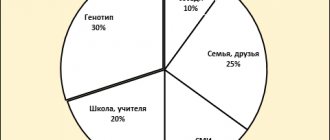The stages of personality development are one of the most interesting and popular topics. This is due to the desire of the individual to learn something secret about himself and become someone even more advanced. Reading about the stages of development, we mentally determine our place in life and look at the near future. This may be an intermediate step between clearly defined stages, or a specific stage. As a rule, in systems describing the stages of development, there are three initial stages along which social people move, one transitional stage, and two or three stages of the spiritual level. In this article I will not make large deviations from the usual canons, but I will try to express my view on the topic stages of personality and consciousness development.
First of all, I would like to say that there is nothing wrong with being at one stage or another. From birth, everyone is forced to go through stages of personality development. And if you jump over a step somewhere, most likely the experience will be incomplete, and you will have to make up for lost time. It is stupid to condemn a first-grader for not being able to solve university problems. If, in your opinion, a person is stupid, perhaps there have not yet been those lessons in his life, thanks to which he could gain wisdom. And in your life there were no lessons that eliminated the roots of the energy-consuming habit of judging. In a developed person, the soul has come a long way, stage by stage. The current stage of development depends on past experiences.
All people are different - each at their own stage, and this phenomenon could best be explained by the concept of rebirth of the soul. It seems like the past is unknown, therefore the result of the past in the form of the current stage of development has to be taken for granted. The acceptability of such an explanation depends on one's personal worldview. If we omit the theory of reincarnation, we can say that the developed personality was lucky - she probably had good genes and living conditions suitable for development.
It makes no sense to condemn people who are “underdeveloped” relative to our level. If a person at his stage of development is weak and cannot solve a problem that seems elementary to us, this means that we are “luckier” - we received a better upbringing and education. If a person avoids difficulties, it means that he is either not ready for them, or he is “unlucky”, and he does not yet understand what lessons can be learned from solving problems independently.
There are no objectively high and low stages of development - everything is relative. And if you get attached to these ranks, there will always be a person on earth who will be two heads taller than you, in comparison with whom our stage will be low. The fewer games of elevation and humiliation, the less waste of energy on a sense of self-importance. However, in our scale of six stages of personality and consciousness development, I will start from the middle levels, to which most of the world’s population are involved, and call the subsequent stages (relatively characteristic of most people) high levels of personality development.
A person at a certain stage of development may have missed lessons from previous stages, which from time to time can emerge in the form of temporary regression. There may also be developments from advanced stages of development - local heights that contribute to an evolutionary career as beacons along the way.
Development criteria
The main criterion for comparing the stages of personality development is the refinement of perception . The subtler the perception, the more subtle shades and facets a person can see in any phenomenon. The rougher the perception, the less picky the personality. What is normal for a person at the first stage of development will seem rude (depending on the situation: stupid, inappropriate, ineffective, overly straightforward) for a more advanced person. And in fact, everything stated below is a slightly more detailed description of how the process of perception becomes more refined from the transition from one stage of personality development to another. There are a number of articles on this topic on progressman.ru under the tag “sensitivity”.
The second criterion for comparing the stages of personality development is foresight , or in other words, wisdom. The wiser a person is, the more he filters the contents of his own mind, and the less he succumbs to gross impulses. Such a person knows that if you have a little patience in the present and work on yourself, the future will not make you disappointed in yourself. On the contrary, a short-sighted person unwisely wastes energy and resources to satisfy himself quickly, without caring about the future.
The third and perhaps the most interesting criterion for comparing stages of personality development is admission by area . This manifests itself as the permission of the “participants” of the sphere to remain in their society, which lives according to certain official or unspoken laws. The subtler the perception and the higher the stage of development, the more subtle and reasonable laws a person accepts, and the stricter the adherence to these laws. If, for example, a person wants to be in close contact with peace-loving and honest people, he himself must become honest and peace-loving, then this sphere will accept him.
The first stage of personality development
This is the stage of a rude person, whose basic interests are almost no different from the interests of animals. Of course, survival, sex and gluttony in the human body are dressed in complex social guises and overgrown with rituals, but the essence remains the same. There is a basic need that overshadows consciousness, and there is a path to this need. If a person at the first stage of development has not acquired social qualities, the path to fulfilling these needs is simplified. The less social there is in a person at the first stage of development, the closer a person’s behavior is to an animal.
Social barriers in the human mind, as a rule, block primitive instincts and place a kind of mental buffer between consciousness and need. The less civilized a person in the first stages of development is, the more strongly the power of his instincts manifests itself, and the more rude and straightforward the fulfillment of his needs will be. In society this results in violence and immoral behavior.
Sometimes a gross desire at the first stage of personality development overshadows consciousness, and a person becomes all the same - just to satisfy this desire. He does not pay attention to the idea that there may be retribution for rude behavior. The strength of the desire and the anticipation of its fulfillment can overpower the subtle awareness of thoughts about the consequences. This is how a lack of awareness, wisdom and foresight is manifested.
At the first stage of personality development, a person almost does not realize that murder and violence are behaviors that must be avoided if a person does not want to become like animals and live according to their laws. The only thing holding him back is fear of punishment and, to a lesser extent, moral values. This happens due to the fact that the perception itself at this level is rough, dull, and therefore a person does not comprehend the third criterion of personality development, associated with admission to spheres that live according to certain laws.
Moreover, a person at this level, to some extent, can distinguish other stages of personality development as more subtle and desirable. But he completely lacks the awareness that the transition to a new level is associated with understanding and observing the laws of more subtle stages of development. No one wants violence against themselves, and in order to avoid this violence, it is necessary to eradicate the manifestation of violence in one’s own behavior, and at a more subtle level in emotions and thoughts.
Speaking of moral and spiritual values, rules and restrictions, they are all artificial and most often simply block the natural flow of vital energy. Their blind acceptance is useful in the first stages of development, until a person himself feels the natural flow of life. In this regard, development is a retreat from the origins in order to gain experience, and then return to them with a matured consciousness.
Graves Dynamics: Application to Life
Now Graves's spiral theory and its description of the dynamics of social development are undoubtedly reaping its benefits: experts from various fields of management, consulting and education are actively implementing the knowledge and assumptions of Graves and his students into life at various levels of society. The dynamics system is especially popular among NLP consultants who help businesses reach a new level of development, formulate fundamental values, a new way of life and a mission.
As many years of experience show, every person goes through the same stages of development and self-realization in society, therefore, by understanding the operating principles of Graves’ spiral dynamics, you can find ways to build a dialogue with a person, determine the vectors of his development, as well as his role and place in society as a whole . And, of course, understanding the Graves system helps a person better understand himself, so this knowledge is useful in any case.
If you are interested in learning more about this man's ideas, you can read his article Levels of Existence: An Open System Theory of Values and the book by his followers Don Beck and Chris Cowan, Spiral Dynamics in Practice, and if you want to know yourself better, we recommend Pay attention to our “Self-Knowledge” course, with the help of which in 4 weeks you will learn your strengths and weaknesses, how to achieve inner harmony, how to build relationships with others and what you really want in life.
We wish you good luck and see you again!
We also recommend reading:
- Storytelling
- The emergence of positivism
- What You May Not Know About Intelligence
- Situationism in psychology and human behavior
- L. Kohlberg's theory of moral development
- Spiral dynamics model
- Fundamentals of neuroeconomics: how do we make decisions?
- Scientific knowledge: basics
- Psycholinguistics as a tool for in-depth study of speech and language
- Four steps to create a personal development plan
- The system of human life values: types of values and formation of the system
Key words: 1Psychoregulation, 1Self-knowledge
The second stage of personality development
This is the stage of the social addict - the “adapted” average person in the street, for whom 90% of all television programs, magazines, games and media news are intended. Here I am omitting books because most of them have a slightly higher level of information presentation.
At this stage, the person intuitively feels that physical violence must be avoided. He can provide his logical rationale for understanding why one should not behave immorally on a physical level. However, the logical explanation is not so important. What is important is the deep experience in his unconscious. If you believe in rebirth, then you can call it the experience of past lives, where a person worked out gross karma. Otherwise, we can talk about genes passed on by worthy parents or proper upbringing. The average person descends to physical violence during regression, when his perception is temporarily dulled.
However, the physical plane is not the only one. And at the second stage of development, a person can be immoral as far as his feelings and thoughts are concerned.
At the second stage of development, for example, a person rarely understands that lying is also violence and disharmony. In other words, here the problem is transferred to a more subtle – mental level. Development as such is concerned with eliminating gross misunderstandings and shifting attention to more subtle imbalances.
At the second stage of development, the survival instinct fades into the background, its influence becomes indirect, but gluttony and lust still remain central needs. The difference with the first stage of development is that consciousness becomes an order of magnitude subtler and needs reveal their shades and qualities. A person begins to play temptation and seduction in order to enjoy what is happening in a more sophisticated way. In sex, foreplay and caresses appear. In addition to meat and booze, there may be an interest in more refined dishes.
A characteristic feature of the second stage of development is the need for pleasure. And since the mental sphere is already developed to some extent, a person, in addition to sex and food, is interested in the pleasures of his mind. This includes: games, entertaining reading, movies, chatter and all kinds of fun.
According to the criterion of wisdom and foresight, a person at the second stage of development made a noticeable step. Now he operates with memory, and is ready to earn money, which he can spend on getting what he wants. At this stage, a person is prone to drug addiction and alcoholism, so it is not for nothing that the social block of information that condemns these tendencies works so actively.
Another criterion of the first two stages of development is degradation in the absence of labor and active activity. If a person in the first two stages suffers from a condition, most likely he will soon die. An exception can only be in the case of strict control by a stronger personality located next to the person of the first two stages of development. In this case, the strong personality protects the weaker from indulging his passions. After all, as you know, drug addiction tends to progress - be it addiction to games, TV, sex, alcohol, or drugs. Fortunately, a second-level person is only in rare cases able to earn huge money on his own. Usually he seems to maneuver between vices and his ability to satisfy them.
Levels of development of personality organization
This chapter will focus on maturational problems that can influence the organization of a person's character, namely, on that aspect of personality structure that, following Freud, is usually called fixation
.
I explore the consequences of possible fixation at three levels of psychological development. Now let me formulate the main diagnostic premise of this work: the essence of character structure cannot be understood without understanding two different and interacting dimensions - the level of development of personal organization and the defensive style within this level.
The first dimension reflects the patient's level of individuation or degree of pathology (psychotic, borderline, neurotic, “normal”); the second denotes the type of person’s character (paranoid, depressive, schizoid, and so on).
A close friend of mine, a person far from psychotherapy, could not understand for himself why people spend time listening to the problems of other people, and tried to understand why I was writing this book. “It seems to me,” he said, “everything is very simple. There are only two categories of people: the first are crazy, the second are not crazy.” I responded that in psychoanalytic theory, which assumes that we are all irrational to some extent, there are two basic questions that need to be answered: (1) “How crazy are we?” and (2) “What exactly are crazy?” In Chapter 2, I briefly pointed out that although most analytic diagnosticians now view child development with less emphasis on drives, unlike Freud, psychoanalysts have never seriously questioned three of his assumptions: (1) existing psychological problems are a reflection of their infantile predecessors. ; (2) interactions in the early years set the template for later perceptions of life experiences, and we unconsciously understand them according to categories that were important in childhood; (3) identifying the level of personality development is a fundamentally important part of our understanding of a person’s character.
It is interesting that, despite all the revisions, the same three phases of infantile* psychological organization continue to remain in the psychoanalytic theory of development: (1) the first year and half of the second year of life (oral phase according to Freud); (2) the interval from one and a half to two years to three years of life (anal phase according to Freud); (3) the time between 3-4 and approximately 6 years of life (Oedipus phase according to Freud). The approximate nature of these stages reflects children's individual differences; the sequence is always the same, even if the child is ahead or behind in development.
Many theorists have discussed the problems solved during these phases either with a bias towards drives and defenses, or towards ego development, or towards self-images and other aspects characteristic of these phases. Some—Daniel Stern (1985)—have subjected existing theories of development to serious criticism based on modern data on child development. However, the clinical relevance of some psychological stage concepts appears to ensure their survival. Gertrude and Robin Blanck (1974, 1979, 1986) have been particularly adept at translating developmental concepts into therapeutic applications. Recent attempts by Phyllis and Robert Tyson to synthesize psychoanalytic theories of development (Phyllis Tyson & Robert Tyson, 1990) are notable for their ease of understanding. In this introductory course, I will mainly synthesize the ideas of Erik Erikson and Margaret Mahler, who explored the maturation of the child's ego abilities and the parallel development of the child's experience of objects and the self.
To my satisfaction, I have not found (and I am in good company here; see, for example, Masling's study [Masling, 1986]) that people with certain "oral" qualities are susceptible to more psychopathology than those whom analysts consider to be anal or oedipal. Although the names given by Freud to these first three phases of development in accordance with their inherent drives contain much that is intuitively attractive and correlates to some extent with the types
personality (depressed people at any level of mental health tend to be oral; compulsive people are notoriously anal in orientation, whether their compulsiveness is a problem for them or not). I have already mentioned the unsuccessful attempts of Karl Abraham to connect the degree of psychopathology with the type of “drive organization”. Since Abraham, no one has been able to do this with sufficient convincing.
And yet they really exist
solid clinical and empirical data (L. Silverman, Lachmann & Milich, 1982) testifying to the existence of a connection between the level of ego development and the “Self-other” distinction, on the one hand, and the health or pathology of personality organization, on the other.
To some extent this correlation comes from the way definitions are introduced and is therefore tautological; that is, to judge the levels of ego and object relations development as primitive is to call the patient “sick,” whereas viewing someone as obsessive or schizoid is not necessarily indicative of pathology. But this way of defining psychological health or impairment, based on the categories of ego psychology, object relations theory and self-psychology, has profound clinical implications for all character types. What follows is a short excursion into the history of psychoanalytic attempts to differentiate between people based on the degree, or “depth,” of their difficulties rather than on type
.











